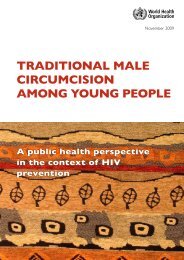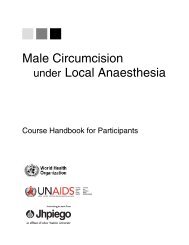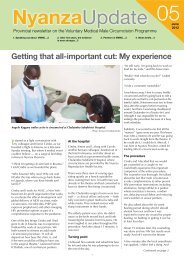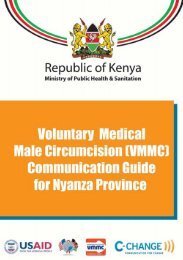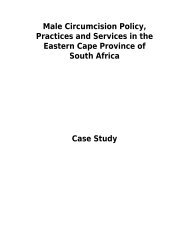Manual for Male Circumcision under Local Anaesthesia
Manual for Male Circumcision under Local Anaesthesia
Manual for Male Circumcision under Local Anaesthesia
You also want an ePaper? Increase the reach of your titles
YUMPU automatically turns print PDFs into web optimized ePapers that Google loves.
<strong>Male</strong> circumcision <strong>under</strong> local anaesthesia Version 2.5C (Jan08)<br />
• injection needles (18- or 21-gauge)<br />
• suture material (chromic gut or vicryl 3-0 and 4-0) with 3/8<br />
circle reverse-cutting needle<br />
• gentian violet (no more than 5 ml) or sterile marker pen<br />
• gloves, masks, caps and aprons<br />
• condoms and in<strong>for</strong>mation materials <strong>for</strong> client.<br />
A specimen list of the disposable materials required <strong>for</strong> one adult<br />
circumcision is given in Appendix 4.2. Equipment should be<br />
disinfected and cleaned as described in Chapter 8.<br />
MAINTENANCE AND REVIEW OF EQUIPMENT<br />
Surgical instruments wear out with use and with repeated<br />
disinfection and sterilization. Each clinic should there<strong>for</strong>e carry<br />
out a periodic review of all surgical instruments. Failure to<br />
maintain instruments in good working condition can cause<br />
operative difficulties and complications. A haemostatic artery<br />
<strong>for</strong>ceps with bent blades, <strong>for</strong> instance, will not properly occlude a<br />
bleeding vessel, while blunt dissection scissors can result in a<br />
ragged wound.<br />
Checklist <strong>for</strong> haemostatic artery <strong>for</strong>ceps<br />
• Do the points meet accurately?<br />
• Is the grip on the points worn?<br />
• Does the ratchet lock securely or is it worn?<br />
Checklist <strong>for</strong> surgical dissection scissors<br />
• Is the cutting edge of the blade sharp?<br />
• Do the blades meet securely?<br />
• Is the screw loose?<br />
Checklist <strong>for</strong> needle holders<br />
• Do the points meet accurately?<br />
• Is the grip on the points worn?<br />
Checklist <strong>for</strong> dissection <strong>for</strong>ceps (tweezers)<br />
• Do the points meet accurately (crossed points are a common<br />
problem with old instruments)?<br />
• If toothed, are the teeth worn?<br />
Facilities and supplies and preparation <strong>for</strong> surgery Chapter 4-3<br />
<strong>Male</strong> circumcision <strong>under</strong> local anaesthesia Version 2.5C (Jan08)<br />
SCREENING ADULT CLIENTS<br />
The circumcision team needs to ensure that clients are fit <strong>for</strong><br />
surgery, are well in<strong>for</strong>med about the surgery and are suitable<br />
<strong>for</strong> circumcision <strong>under</strong> local anaesthesia in their clinic. If there<br />
is any doubt as to a client’s suitability, he should be referred to<br />
the district hospital or higher level of care.<br />
The circumcision team should take a focused medical history<br />
and per<strong>for</strong>m a clinical examination of the penis. Both the<br />
history and the examination should be documented (see<br />
sample record <strong>for</strong>m in Appendix 4.1).<br />
History<br />
When taking the medical history, enquire about:<br />
• current general health;<br />
• whether the client is taking any medicines;<br />
• whether the client has any known allergies to medicines;<br />
• history of haemophilia, bleeding disorders or anaemia;<br />
• any current genital infection, ulcer or penile discharge (see<br />
Chapter 2);<br />
• whether the client has problems with penile erection or any<br />
other concerns about sexual function.<br />
There are few medical contraindications to circumcision <strong>under</strong><br />
local anaesthesia. However, as <strong>for</strong> all elective surgery,<br />
circumcision should not be per<strong>for</strong>med on anyone suffering<br />
from an acute disorder, infection or febrile illness. In this case,<br />
the operation should be deferred until the problem has been<br />
resolved.<br />
Physical examination<br />
The anatomy and structure of the normal penis are described<br />
and illustrated in Appendix 4.3. When examining the penis,<br />
retract the <strong>for</strong>eskin and inspect the glans. The urinary opening<br />
(urethral meatus) should be near the tip of the glans, and<br />
should not be scarred or diseased. The <strong>for</strong>eskin should be<br />
easily retractable and not inflamed or narrowed. If the penis,<br />
glans, meatus and <strong>for</strong>eskin are healthy, the client is suitable <strong>for</strong><br />
circumcision in the clinic.<br />
Facilities and supplies and preparation <strong>for</strong> surgery Chapter 4-4





